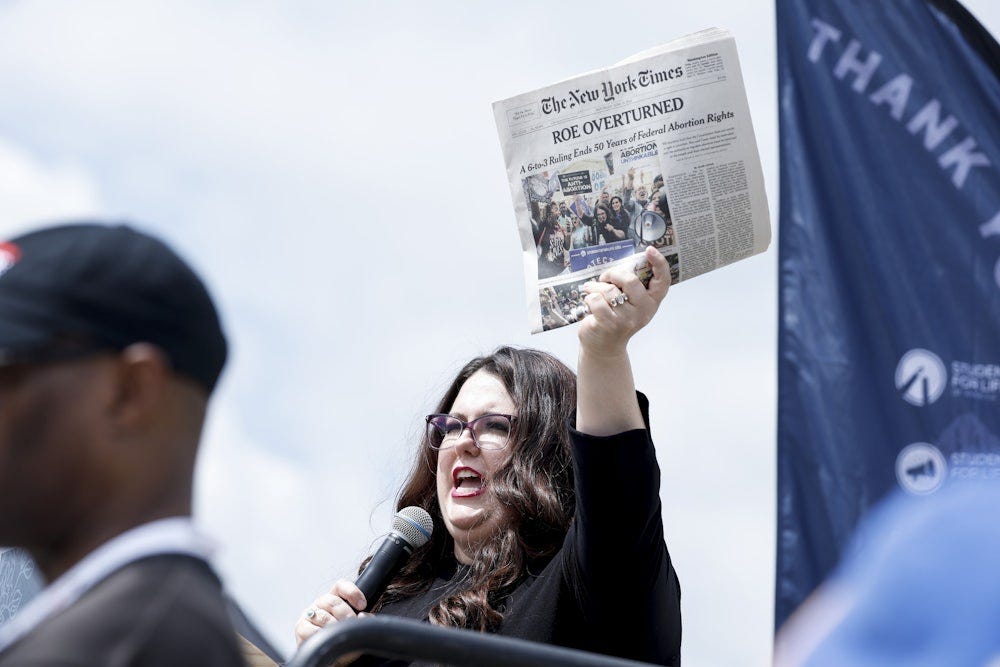Anti-Abortion Activists Want to Have It Both Ways
You can’t “return abortion to the states” and then get upset when states protect abortion rights.
Since Roe was overturned, abortion rates have gone up in most states with abortion bans, The New York Times reported Wednesday. Perhaps this might alarm anti-abortion activists like Kristan Hawkins, president of the anti-choice group Students for Life America, prominent among those who helped end Roe, and who the Times interviewed for its story. For Hawkins, the fault lies with states doing exactly what the Dobbs decision allowed them to do: make their own abortion laws. “A serious breakdown in the law takes place when one state attempts to interfere with another state’s efforts to protect their citizens,” Hawkins told the Times.
This is, obviously, spin. But what’s striking is how Hawkins’s spin contradicts the prominent narrative of conservatives, including Donald Trump and JD Vance, who claim that Dobbs merely “returned abortion to the states.” Claiming that Dobbs simply empowered the states to decide is how Republicans attempt to have it both ways: acknowledge the popularity of legal abortion yet still please the anti-abortion activists they need on their side.
Hawkins, though, maintains that having 50 competing legal regimes governing abortion would be total chaos. And the implied solution to all this disorder is simple: a national ban on abortion.
Hawkins is not some undergraduate with edgy, “heterodox” opinions, the kind who pops up in the pages of the Times with some frequency. Around the time she actually was a student, according to her own biography, she was working for the Republican National Committee and was an appointee in the George W. Bush administration. Students for Life may sound like a smallish group who hand out literature on campus—some chapters do—but conservative dark money maestro Leonard Leo sits on their board. They are in the same network of Leo-backed groups, such as the Heritage Foundation and Alliance Defending Freedom, who lobby Congress together and file amici briefs in the same Supreme Court cases, including the case meant to take mifepristone, which can be used for abortions, off the market. Heritage Foundation president Kevin Roberts spoke at Students for Life’s annual summit in January. “We meet today amid a pro-abortion media narrative of smug triumphalism,” Roberts told the student attendees. Heritage also had a Project 2025 promotional booth. The Project 2025 anti-abortion agenda shares much with Students for Life’s.
Even when it wins, the anti-abortion movement poses as the victims. No one should be surprised that Hawkins, who seeks an end to abortion altogether, is not concerned with “states’ rights,” as it were. A national ban is already part of the Republican Party platform adopted at this year’s convention, even though Trump and Vance may pretend it is not. I don’t mean the platform’s single use of the word “abortion,” which appears in its opposition to “Late Term Abortion.” Rather, the gesture toward a possible national abortion ban is buried in what might read like the most banal reiteration of promises to uphold the Constitution: “We believe that the 14th Amendment to the Constitution of the United States guarantees that no person can be denied Life or Liberty without Due Process, and that the States are, therefore, free to pass Laws protecting those Rights.” This is a thinly veiled reference to a dubious anti-abortion legal strategy: that a fertilized egg is a legal person with constitutional rights—rights that, inevitably, outweigh the rights of the pregnant person.
That’s an incredibly extreme move, one that shreds the intentions of the Fourteenth Amendment, one of three Reconstruction-era amendments that recognized recently emancipated Black people in the United States as citizens, and the cornerstone of countless civil rights decisions by the Supreme Court into the twentieth century—including Roe. Hawkins is extreme, even by anti-abortion movement standards. She wants to outlaw birth control pills and IUDs, claiming they “put women at risk and they kill children.” As part of this effort, she and Students for Life routinely push health misinformation, casting contraception as a form of abortion, or insisting that an abortion to save the life of the mother is not an abortion but an act of “maternal-fetal separation.” She must know, as she can see the same polls everyone else does, that such positions are deeply, deeply unpopular. That may be why some of the more extreme measures she is pushing, such as giving fertilized eggs rights as legal persons, tend to come a bit cloaked or buried in jargon.
Hawkins was not wrong when she tried to paint the post-Roe world as one in which states’ laws are interfering with one another, with pregnant people caught between conflicts in the laws where they live and the laws where they travel to obtain an abortion. But she is not being honest. She helped unleash this chaos. And now she wants to benefit from it.





